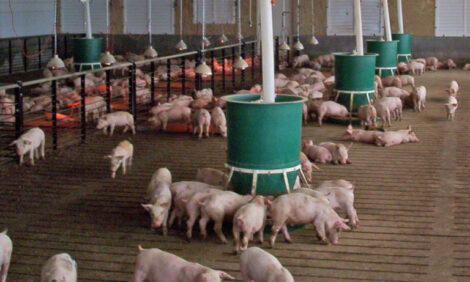



US Pork Outlook Report - June 2010
As usual, the three largest foreign destinations for US pork exorts in April were Japan, Mexico and Canada, according to the USDA's Economic Research Service (ERS) Livestock, Dairy and Poultry Outlook report for June 2010.Summary
For 2010 in total, pork production is expected to be 22.1 billion pounds, or 3.8 per cent below 2009 levels, as production in the second and third quarters will be lower than year-earlier. Hog prices (51-52 per cent lean) continue to reflect lower supplies and recovering consumer demand. Second-quarter prices are expected to average $59 to $60 per hundredweight (cwt). Although hog prices have probably peaked, they are expected to continue much above last year’s levels and should exceed producer break-even levels for 2010 and into 2011. April pork imports rose almost 36 per cent, likely due to higher US pork prices and a stronger dollar.
Lower Slaughter Numbers Reduce Second-Quarter Pork Production Slightly
Hog slaughter has slowed more than anticipated since the beginning of the second quarter. Slightly higher average dressed weights are expected to mitigate some of the production effects of lower slaughter numbers, but even so, USDA reduced the second-quarter pork production estimate by 95 million pounds. Third-quarter production was also reduced by 20 million pounds, in anticipation of slightly lower slaughter numbers. Second-quarter commercial pork production is forecast at 5.22 billion pounds, 5 per cent below production a year ago. Third-quarter production of 5.4 billion pounds is anticipated, 5.3 per cent below the same period last year. For 2010 in total, pork production is expected to be 22.1 billion pounds, 3.8 per cent below production in 2009.
Through May of this year, prices of live equivalent 51-52-per cent lean hogs are averaging 28 per cent above prices of a year ago. Lower slaughter numbers and slowly recovering consumer demand for pork products—both domestic and foreign—are the likely factors that have driven prices higher this year. As indicated in the figure below, hog prices are well above those of last year. Although prices have likely achieved their seasonal high, they are expected to remain well above last year’s prices in the second half of 2010. Given USDA’s forecasts for corn and soybean meal, hog prices are expected to remain above most hog producers’ breakeven levels for the remainder of 2010 and into 2011. Hog prices are expected to average $59 to $60 per cwt for the second quarter, and $54 to 57 per cwt for 2010.
USDA will publish the Quarterly Hogs and Pigs report on 25 June 2010 providing an opportunity to understand and quantify hog producers’ response to recent positive returns.

April Pork Exports Increase Year-Over-Year
The pace of US pork exports was steady in April, with US companies shipping almost 353 million pounds of pork products to foreign destinations, 2.2 per cent ahead of April 2009. The three largest foreign destinations were, as usual, Japan, Mexico, and Canada. Japan accounted for more than 36 per cent of US pork exports in April, importing 6.4 per cent more US pork than a year ago. Exports to Mexico were 30 per cent higher than April 2009. Mexico’s share of US pork exports in April was 22 per cent, and when compared with its April 2009 share of 17 per cent, demonstrates Mexico’s increasing importance as a US export destination. Canada remained a solid export market in April: shipments were almost 18 per cent above a year ago. Canada accounted for almost 9 per cent of US shipments in April. With the exception of Japan and Taiwan, where US exports increased by 13.7 per cent, US exports to Asia were almost uniformly lower than in April 2009, including to South Korea (-28 per cent), China (-91 per cent), and Hong Kong (-0.6 per cent).
US pork imports were 4.6 per cent lower in April compared with those of a year ago. Lower purchases of Canadian and Danish pork accounted for most of the reduction. April swine imports were also year-over-year lower (-14.4 per cent), with lower segregated early-weaned animals and heavier animals for finishing accounting for most of the reduction.
Further Reading
| - | You can view the full report by clicking here. |
June 2010








